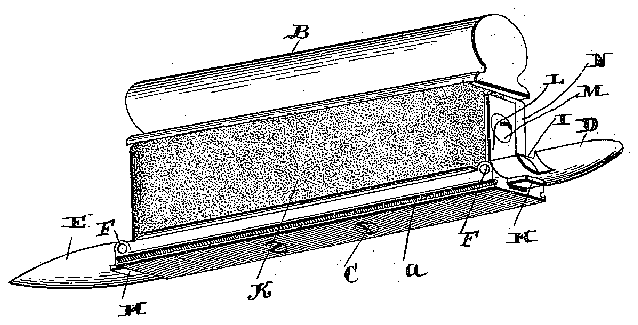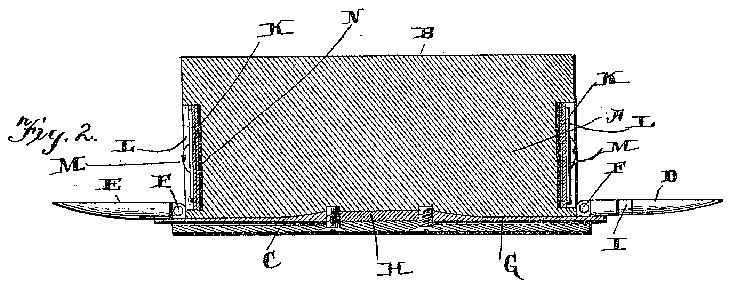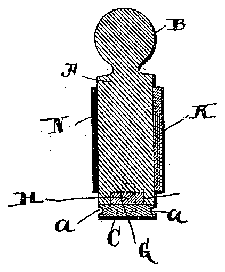


- 18 application filedmarch
- 30file
Description
H. CLAYTON. MANIGURE IMPLEMENT.'
(N0 Model.)
Patented Jan. 9, 1894.
-- Z JInIIII'IIIrII/rwlI/ UNITED STATES PATENT OFFICE.
HERBERT CLAYTON, OF BROOKLYN, NEW YORK.
MANICURE IMPLEMENT.
SPECIFICATION forming part of Letters Patent No. 512,277, dated January 9, 1894.
Application filedMarch 18, 1893. Serial No- 466.693- (ITo model.)
To aZZ whom it may concern:
Be it known that I, HERBERT. CLAYTON, of Brooklyn, in the county of Kings and State ofNew York, have invented certain new and useful Improvements in Toilet Articles; and I do hereby declare the following to be a full, clear, and exact description of the invention, such as will enable others skilled in the art to which it pertains to make and use it, reference being had to the accompanying drawings,'which form part of this specification.
My invention relates to animprovement in toilet articles, and it consists in the construction hereinafter fully described and particularly pointed out in the claims.
The object of my invention is to provide an improved toilet article comprising ablock forming a handle having at its sides and edges devices for cutting, cleaning, filing and polishing the nails, and a device for filing corns, the same being constructed, substantially as hereinafter shown and described.
In the accompanying drawings, Figure 1, is a perspective View of my invention. Fig. 2, is avertical longitudinal sectional view. Fig. 3, is a transverse central sectional View.
A indicates'a block having its upper edge B formed round to constitute a handle, and the portion A slightly reduced in length to have the handle part B to project over, as shown clearly in Figs. 1 and 3.
Attached to the lower edge of the block A, is a file G, which'extends from end to end thereof and has on its upper side just beyond the ends of the block A, the vertical lugs F, between which are pivoted the blades D and E. A longitudinal groove G is made in the edge of the block just above the file O, which receives a spring H, the extremities of the said spring extending outward under the inner ends of theblades D and E, for the purpose of holding them in a horizontal and a vertical position in the same manner of a knife blade spring, as will be clearly understood from Fig. 2. The file O has its outer face roughened throughout as shown in Fig. 1, and its opposite edges provided with a 1011- gitudinal groove a, which is also roughened,
both being used for the purpose of filing the nails, as is usual in such constructions.
Attached to one side of the block Aare sev eral pieces or sheets of sand paper K one outside of the other as clearly shown in Fig. 3, the ends of the said sheets lapping around on the ends of the block and held in place by means of the screws M and washers L, as shown in Figs. 1 and 2. The object of having several sheets of sand paper is that when one has been used till it has lost its sharpness, it is readily torn from the block, exposing a new sheet for use. This sand paper is designed for the purpose of filing corns and very effectually cuts them off even with the skin without causing any bleeding, which is very dangerous. At the opposite side of the block A, is a piece of chamois N which has its end also Wrapped around the end of the block A, and placed under the washers L, which are held in place by the screws M. The purpose of having the block A cut away, as before described, and the handle B projecting thereover is to allow space for the washers and screws, so that each blade D and E, will fold up in a vertical position against the end of the block A. The blade E is made sharp for readily cleaning the nails, while the end of the blade D is made rounded for the purpose of fixing the skin at the root of the nails and making them smooth, and thus materially improving the appearance of the nails.
Made in one edge of one of the blades, preferably the one D, is a notch I, which has a sharpened outer edge, for the purpose of cutting the nails. Owing to the concave shape of this notch the nails are very effectually removed at a regular distance from the end of the finger.
From the above description it will be seen that I produce a very simple and cheap toilet article combining the essential features of a complete manicure set for toilet use. I do not however limit myself to the specific construc-, tion of the several devices in some minor respects, for it is evident that these may be varied Without departing from the spirit of my invention.
Having thus described my invention, what I claim, and desire to secure by Letters Patent, is-
1. A manicure article consisting of a block having one edge forming a'handle, a file attached to the opposite edge providedwith blades at each end thereof, and manicure sheets attached to the sides of the block between the handle and the file, substantially as set forth.
2. A toilet article comprising a block forming a handle, sheets applied to the sides thereof, the ends of the sheets lapping around the ends of the block and connected thereto, afile connected to the edge of the block having blades attached to the ends thereof, substantially as described. 7
3. A toilet article comprising a block, a file attached to the edge thereof, a longitudinaL groove, a spring placed within the groove overlapping the ends of the file, and blades pivoted to the file over said spring, whereby they are engaged by the spring, substantially as shown and described.
4:. A toilet article comprising a block having its lower portion shorter than its upper portion for the purpose described, sheets connected to the sides of the block with their 20 tween the lugs, and springs above the file 30 which engage the inner edge of the blades, substantially as set forth.
In testimony whereof I aifix my signature in presence of two witnesses. W v
' HERBERT CLAYTON.
Witnesses:
O. O. PATTERSON, HENRY J. VOGEL.
